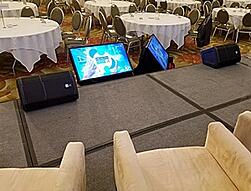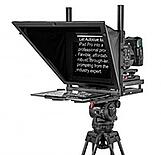One thing that comes up time and time again that is generally misunderstood is the difference between a confidence monitor (or a Down Stage Monitor – DSM) and a teleprompter. A confidence monitor is usually a TV screen anywhere from 32” to 60” that sits on the floor at the foot of the stage, and allows presenters on stage to see what slide is on the screens without turning their backs to the audience.
 Some presenters prefer to see one slide ahead, and some will require two or even three confidence monitors so that they can see any combination of the current slide, slide ahead, and maybe even some notes. *GASP!* Powerpoint can even show a “presenter’s view” with notes! And it conveniently doesn’t offer you much room to see your notes! Especially not on a TV monitor that’s 10 – 15 feet from your eyes. And of course, all of these screens generally need to advance at the same time, or with at least some sort of specific synchronicity, known only to the presenter and handlers, and none of who generally can give us what we as AV operators need in a plug-and-play format.
Some presenters prefer to see one slide ahead, and some will require two or even three confidence monitors so that they can see any combination of the current slide, slide ahead, and maybe even some notes. *GASP!* Powerpoint can even show a “presenter’s view” with notes! And it conveniently doesn’t offer you much room to see your notes! Especially not on a TV monitor that’s 10 – 15 feet from your eyes. And of course, all of these screens generally need to advance at the same time, or with at least some sort of specific synchronicity, known only to the presenter and handlers, and none of who generally can give us what we as AV operators need in a plug-and-play format.
There’s always tweaking, and converting, and copying, and pasting. It’s messy and it takes time.
 If your presenter wants to read from a script that’s not physically on paper in front of them, then you really need a teleprompter. A device with its own operator who follows along and feeds you every word you’re saying on stage, at your own pace. It’s like having someone out in the audience guide you to the perfect delivery of your material.
If your presenter wants to read from a script that’s not physically on paper in front of them, then you really need a teleprompter. A device with its own operator who follows along and feeds you every word you’re saying on stage, at your own pace. It’s like having someone out in the audience guide you to the perfect delivery of your material.
And that’s not what a confidence monitor is for. AV engineers can’t guide you like that with a confidence monitor. Got a few notes for each slide? No problem! New powerpoint, and one note slide per presentation slide. Piece of cake. If your notes need more than one page, or are too small and you can’t even read them, then you may want a teleprompter instead. Or note cards.
Tip: A lot of events now take questions from people who aren’t in the room. Whether it’s someone on Twitter following along, or a client watching a live stream, there is always the task of how to get their questions to the stage. Confidence monitors can be a great fit for this. You can filter out which questions to ask, type them right up on a laptop and let your presenters see and respond to exactly what you want them to.


